Building a Stratum 1 NTP Server Using Raspberry Pi
-
You really need to compare over a long time window, add both NTP sources to pfSense's NTP server, enable monitoring and you can observe long term trends under diagnostics.
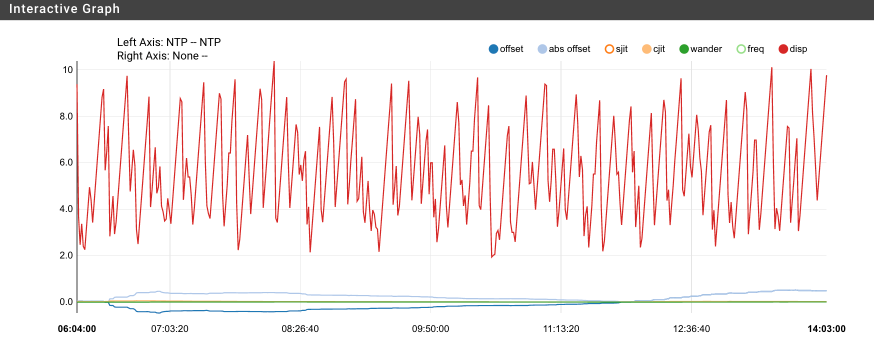
-
@johnpoz do you still have that uptronic running? it's basically the same one I have but from another vendor
would you mind sharing your ntp.conf?
i actually have this on my ntp.conf but compared to the adafruit is not that goodublox config ->
server 127.127.20.0 mode 89 iburst prefer fudge 127.127.20.0 flag1 0 flag3 0 time1 0.0 time2 0.048 refid GPS server 127.127.22.0 fudge 127.127.22.0 flag3 1 time2 0.0 refid PPSgps output
pi@raspberrypi3:~ $ cat /dev/gps0 $GNRMC,124146.00,A,4520.67417,N,01147.19928,E,0.138,,051220,,,A*6C $GNZDA,124146.00,05,12,2020,00,00*7Aublox ->
*127.127.20.0 .GPS. 0 l 46 64 377 0.000 9.572 0.800 o127.127.22.0 .PPS. 0 l 45 64 377 0.000 4.465 0.339adafruit part of it.pool.ntp.org ->
oNMEA(0) .GPS. 0 l 1 64 377 0.0000 0.0042 0.0199 -
what are you looking for exactly? I am running ntpsec
Keep in mind the sat signal just meant to get you close - the thing that keeps your time the pps
The signal from gps will almost never be the selected source..
And unless you don't have internet to get you close via another ntp source the gps signal doesn't mean all that much...
Your looking for a ntp server that time is stable and doesn't drift, that comes from the pps signal.
I don't bother playing with the fudge factors trying to get the gps to be inline with other time sources with very little offset, because in the big picture it doesn't matter.
But this does remind me that should prob update my ntpsec version.. Its a bit dated.. 1.2 came out back in oct.
Here is what I used to setup mine when I switched to ntpsec
https://www.ntpsec.org/white-papers/stratum-1-microserver-howto/edit: Well this turned into a bit more than just clockmaker --update ;) updating my pi to buster from stretch.. Lets hope it works ;) I didn't bother to take a backup.. And just doing a dist-upgrade.. Either be real simple - or will force me to do a clean install.. Seems openssl doesn't have package for tls 1.3 support in stretch.. It's always something, and the new version of ntpsec seems to want that to compile.
-
@johnpoz
i was referring to the offset and jitter , it's much loweron the adafruit,
the difference between the adafruit and the ublox is that the adafruit have the pps signal inside /dev/gps0 so i only need
server 127.127.20.0
and with flag1 1 I have gps+pps
you see it because NMEA have the 'o' instead of only the '*'with the ublox instead i have to use /dev/gps0 and /dev/pps0 but it end up with larger offset/jitter and it drift up and down very mutch during the day compare to the adafruit, i will wait another 24h and i'll show you how the graph from the adafruit is linear but the ublox is not
I'm not using gpsd / shm but direct driver, thanks for the link i will try that if i'm unable to achieve better results with my config
-
Ok... So I just rebooted and updated mine to ntpsec 1.2 so current values a bit off..
ntpq> version ntpsec-1.2.0+ 2020-12-05T14:15:31Z (git rev 9842b560f)But looking over the data for last 2 days so can see 5 min entries.. This looks pretty stable to me
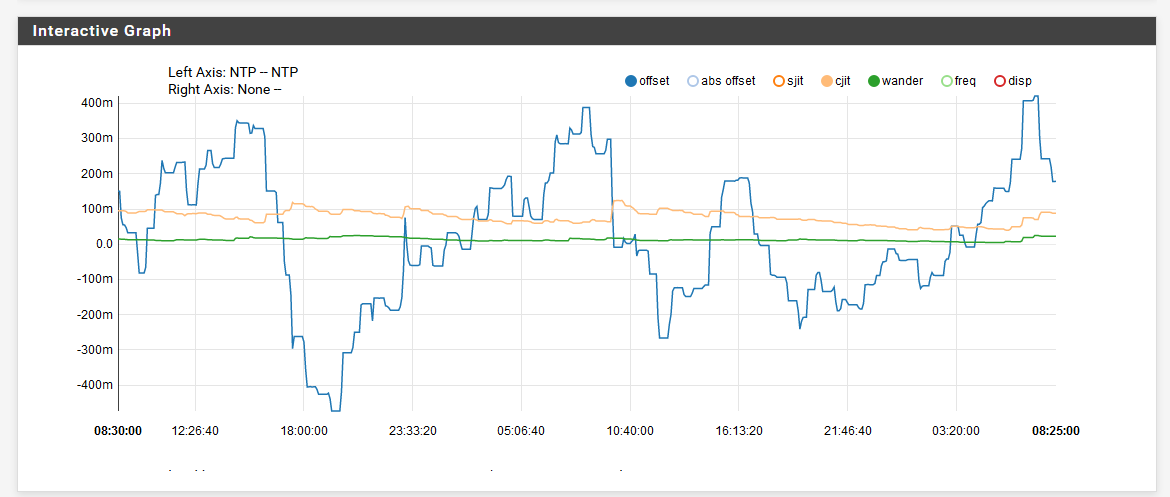
Those are micro seconds.. Not miliseconds.. Max offset of 0.42 ms, or 0.00042 seconds..
That clock jitter is pretty flat..
edit: Question for you, your running min pi install right? Or did you install the gui on your pi?
edit2: If your looking for some tuning advice check out
https://gpsd.gitlab.io/gpsd/gpsd-time-service-howto.html#_performance_tuning -
@johnpoz
yes, i'm running min install without any gui / stripped services -
Lets see what your graphs look like after some time.. Its going to take a bit to stabilize.. How often are you polling your shm entries?
If you were using ntpsec vs ntp you could just use the refclock entry in the ntp.conf to set an offset for your gps after you have determined what that is via say syncing with some very stable stratum 1 servers..
With ntp you have to use the fudge servers to do a specific offset.. But that is not what effects jitter..
I understand there is something to do with the different hats and if they are using edge or falling of the pps signal which could introduce offset, etc. And yeah I think jitter because of some bug... There was something I was reading about that - I believe it was in the link I provided about ntpsec setup.
edit: Yup here it was
https://www.ntpsec.org/white-papers/stratum-1-microserver-howto/#_edge_detection_issues_and_new_hatsedit2: I just finished up playing with mine.. Have to check it in a few days.. But yeah mine is going to take a bit to fall back into rhythm.. I updated the distro, I updated ntpsec and couple of reboots in there, etc..
So you can see mine is a bit crazy right now as well
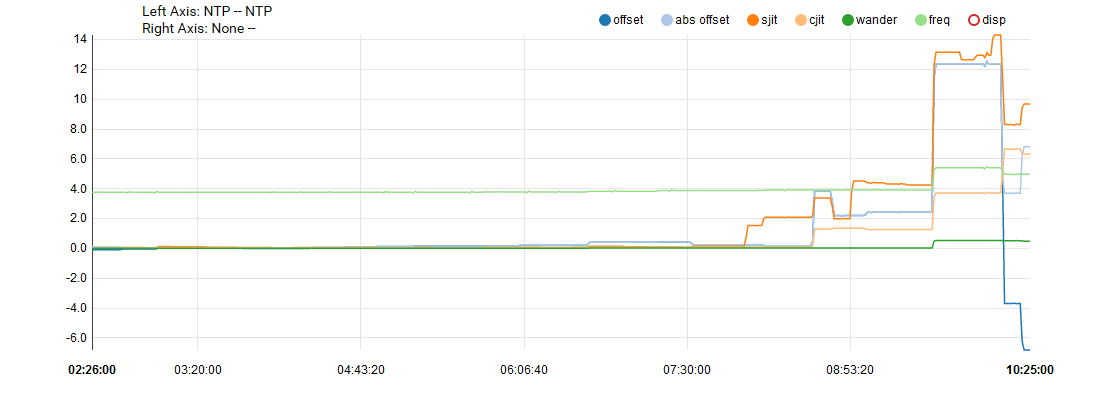
edit3: If your going to run ntp server - you might want to add it to the pool.. For one you get an email if it gets too wacky or is not working.. So its a way to monitor how your ntp is performing.. As you can see mine is going to take a bit to get back into good running.. Check out the last entries compared to how well grouped the previous checks were..

-
@johnpoz
i don't use shm anyway this is the difference i see between the 2 gps
i restarted the ublox service around 13:00, where you see the spike

adafruit
green is pps+gps
ublox
yellow is pps green is gps -
That is same same pi make and model. Same setup just the difference in the hats?
Wow - something seems off there.. I can see why your interested now..
What specific pi? And what specific hat? Maybe I will order one ;)
-
@johnpoz
yes both are raspberry pi 4 with 4gb same debian but different hat -
What are you using to graph that like that? I would be up for getting a pi4 and the same hat to test.. Always up for fun projects ;)
Trying to find an excuse to get a 4 ;) hehehe
You seem to be pretty for out on the same hat I have, your ublox
remote refid st t when poll reach delay offset jitter ======================================================================================================= *SHM(1) .PPS. 0 l 2 16 377 0.0000 -0.3426 0.0026Is the hat you got.. You had to solder?
https://www.adafruit.com/product/2324 -
@johnpoz
that is telegraf sending to grafana
grafana sitting on another raspberry ..
https://www.adafruit.com/product/2324
https://www.waveshare.com/max-m8q-gnss-hat.htmadafruit need soldering this but it's easy

-
Are those values actually in milliseconds or is it microseconds and just mislabeled?
Steve
-
@stephenw10
the values from ntpq afaik is milliseconds ? -
Yes, it reads in milliseconds but that can get confusing when is shows a value like 0.001 (1μs).
Values in microseconds are what you should expect if PPS is working.
Less than 1μs is impressive. I generally see between 1-2μs here.
Steve
-
@kiokoman said in Building a Stratum 1 NTP Server Using Raspberry Pi:
and it drift up and down very mutch during the day compare to the adafruit
Is your device thermally stable, without some kind of TCXO its likely drift. I see fluctuations around 11am to 4pm as the sun hits the room where my timing hardware is located. Temperature corrected devices are unaffected.
Also, different drivers are very likely to introduce different levels of performance so try and ensure you are using same drivers (type 22 PPS vs SHM type 28 etc).
-
yeah, i'm using only type 20 and type 22
but i think i was finally able to find a configuration that suits ithttp://www.philrandal.co.uk/blog/archives/04-01-2019_04-30-2019.html
with some minor adjustment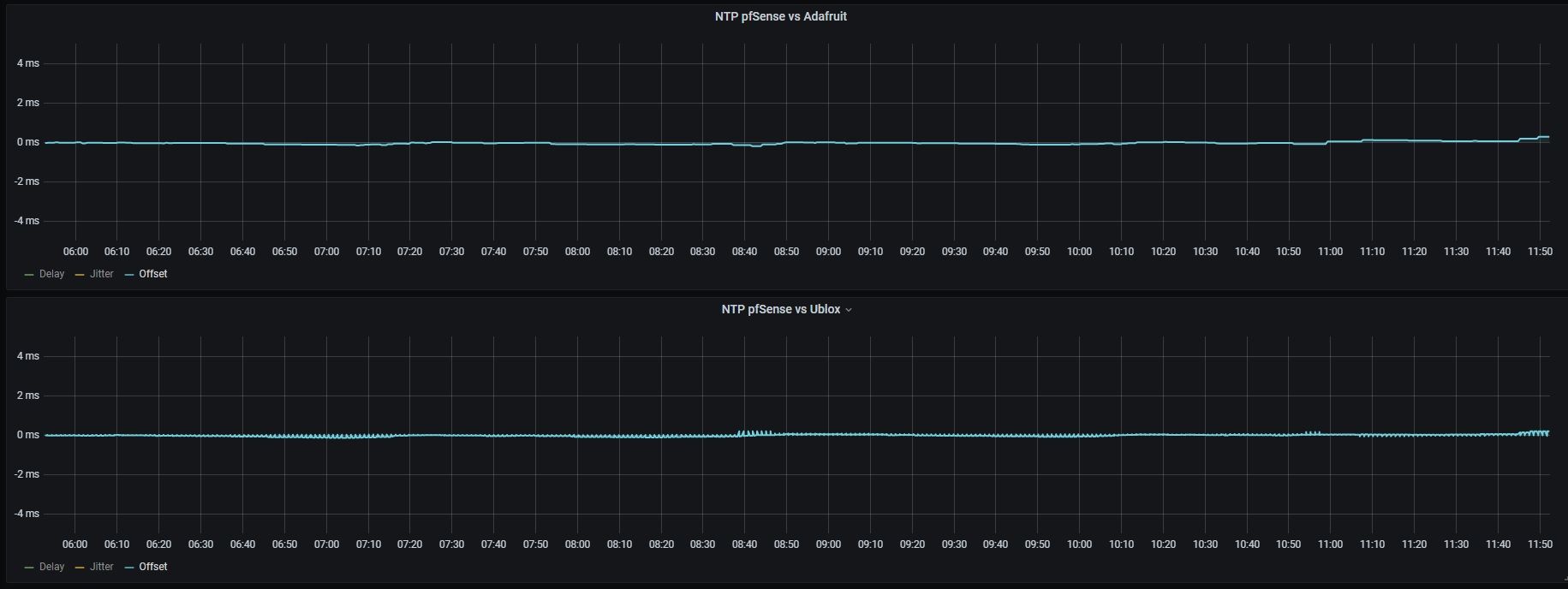

-
I'll answer your question about nohz
it does not work on raspberry pi 4 + raspbian
the kernel isn't configured to allows the nohz parameter to work
also, I found that you can only use
flag 3 0 (use the ntpd clock discipline)
and not
flag 3 1 (use the kernel discipline)
for PPS
if you try to use flag 3 1 you see in the syslog this:refclock_params: time_pps_kcbind: Operation not supportedthis is because the kernel is compiled without CONFIG_NTP_PPS

obviusly
as a good nerd I recompiled ...
this is ublox now
server 127.127.20.0 mode 89 iburst prefer minpoll 2 maxpoll 4 fudge 127.127.20.0 flag1 1 flag3 1 time1 0.0 time2 0.025 refid GPSpi@raspberrypi3:~/linux $ uname -a Linux raspberrypi3 4.19.118-v7lntp+ #1 SMP Fri Dec 11 14:42:08 CET 2020 armv7l GNU/Linuxpi@raspberrypi3:~/linux $ ntpq -crv -pn status=041d leap_none, sync_uhf_radio, 1 event, kern, version="ntpd ntpsec-1.1.3 2019-11-18T06:04:00Z", processor="armv7l", system=" Linux/4.19.118-v7lntp+", leap=00, stratum=1, precision=-20, rootdelay=0.0, rootdisp=2.18, refid=GPS, reftime=e37e600c.8bd6769d 2020-12-11T21:15:56.546Z, clock=e37e6018.d0a57250 2020-12-11T21:16:08.815Z, peer=11020, tc=4, mintc=0, offset=7.8e-05, frequency=-18.907623, sys_jitter=0.000277, clk_jitter=0.000728, clk_wander=0.001816, tai=37, leapsec="2017-01-01T00:00Z", expire="2021-06-28T00:00Z" remote refid st t when poll reach delay offset jitter ======================================================================================================= oNMEA(0) .GPS. 0 l 12 16 377 0.0000 0.0001 0.0003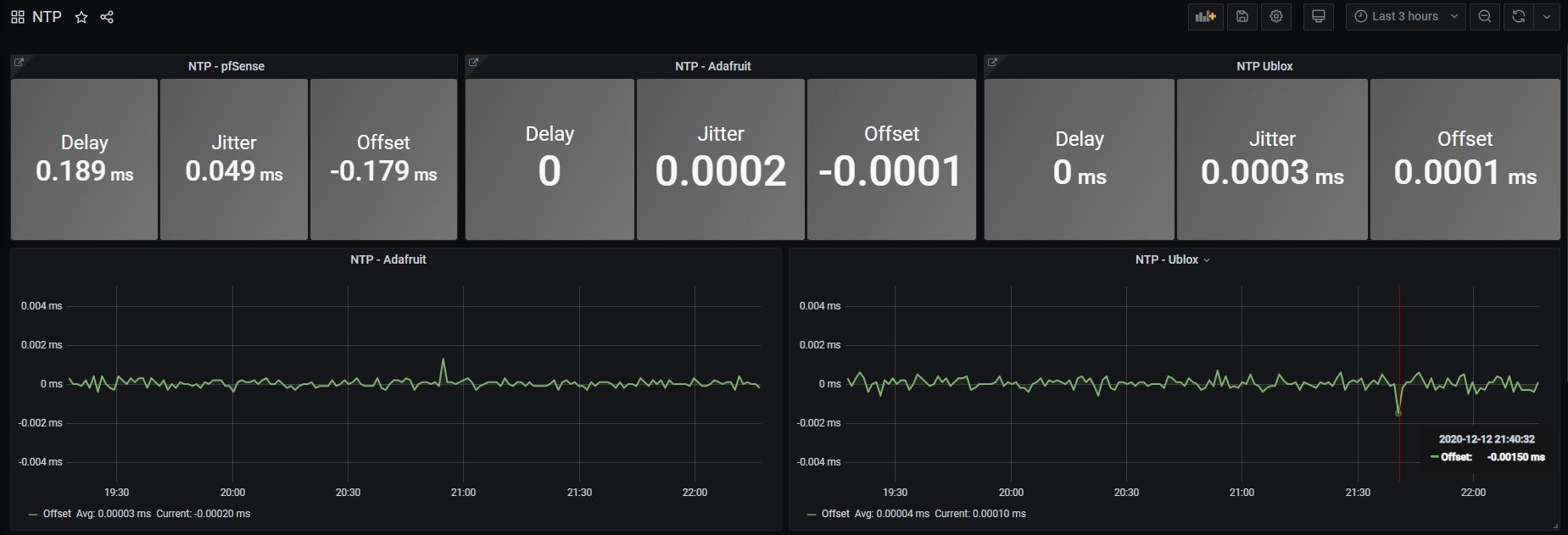
-
This post is deleted! -
Hi all -
Wanted to follow up on this thread as I recently acquired a Stratum 1 NTP server for my network (LeoNTP - very cool little device). Currently, I have it setup as the only NTP time server on pfSense (i.e. no other servers are configured). Is this an acceptable setup, or should I be adding a few additional public Stratum 1 servers as a sanity check, and set the LeoNTP device as the preferred server? I realize with just one server I don't have any redundancy, but is that the only main drawback? Thanks in advance!